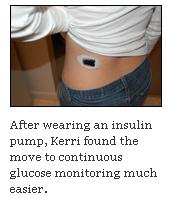The CGM Revolution: Why I Fought For It and Why It’s Been Worth It
By Kerri Sparling

by kerri morrone sparling
The switch from injections to pump therapy was a big leap. At the time, I was having low blood sugars two to three times a week, and my then-roommate was constantly finding me unresponsive in the bed at 6 am, covered with sweat and in desperate need of juice. After 17 years of injections and two years of an A1c that wouldn't budge, I made the decision to use an insulin pump. It was the introduction of a “medical device” onto my otherwise unadorned body (aside from earrings and that belly button ring my father is still angry at me for getting). But over time, I adjusted to the device and became used to wearing my external pancreas (despite a few incidents in getting my tubing stuck on doorknobs and finding places to hide the pump in fancy dresses – small hurdles when compared to nine injections a day and frighteningly low blood sugars).
After wearing one medical device, it was easier to try another one. A few years of pumping made me feel comfortable with the 24/7 attachment of a diabetes device, so when continuous glucose monitors became more prevalent, my interest was piqued. At the time, I was in a serious relationship and thinking more and more about having children in the future. Realizing how my A1c was still struggling to hold close to 7%, it was time to try something a bit different.

There are pros and cons aplenty, but once I decided to use a CGM system, I ran into some very frustrating hurdles that had nothing to do with personal preference. My insurance company deemed my diabetes “too well-controlled,” and because I wasn’t being taken to the emergency room by ambulance every few days, I wasn’t “sick” enough to warrant such a pricey approval. (Apparently, hypoglycemic unawareness wasn’t enough for them. A blood sugar of 29 mg/dl without a whisper of a symptom wasn’t enough. They wanted me seizing on the floor before they’d approve coverage?) I fought long and hard for insurance approval, knowing that the CGM would be a terrific asset in helping me manage my blood sugars during pregnancy. Eventually, the JDRF study regarding the impact of CGMs on diabetes control was released (see Conference Pearls from diaTribe #12 and #16) and that helped push my insurance company, and subsequently my CGM approval, over the edge.
But there was still the "Hey, you're even more of a robot" component to wearing a second device. I can't lie: when I look at my body and I see all these things stuck to me, in addition to the red dots of diabetes devices past, I feel a little overwhelmed. But it's part of living with this condition. (Most of the time, I'm able to shake off the robot feeling and just let my husband Chris call me Rosie. Whoops – I digress.) I actually feel okay with wearing two medical devices. It's sometimes cumbersome and inconvenient, and the CGM isn’t always spot-on with my meter results. It’s also hard at times to remember that this is a tool used to track blood sugar trends, not precise glucose results. And when it BEEEEPs in the middle of the night because I’m low or high, it can make me feel like a diabetes failure.
But for me, the pros outweigh any cons. The beeping can help save me from several hours with an elevated blood sugar, or it can wake me up when I’m tumbling toward 40 mg/dl. While it’s a constant reminder of diabetes and not always a positive reinforcement tool, it does prompt me to keep closer tabs on my numbers, and to test my blood sugar more regularly. I hear a lot of bad news about diabetes, about how this many years with type 1 can cause a landslide of issues, about how life can be compromised. I don't want that.
And now I’m seven months pregnant with my first baby – my daughter – and I’m constantly thankful for the diabetes technology developments that have taken shape since my diagnosis in 1986. My insulin needs are changing every few weeks, and it’s largely in thanks to the CGM and the pump that I’m able to (sort of) keep up with the demands of my growing baby bump. Working closely with my medical team at the Joslin Clinic, I’m using every bit of technology available to keep my baby safe. I owe it to her, as her mommy, to try my best.
Diabetes may be affecting my pregnancy heavily, but I’m working very hard to make sure it doesn’t affect my daughter. My A1c has been remarkably low (for me) during the course of my pregnancy, and I want to maintain that trend, both for my health and for the health of my child. Regardless of what happens in my future, I’m making every effort to be as healthy as I can, both mentally and physically. And I'm ready to keep trying, working with technology through its growing pains as it works with me through mine.









